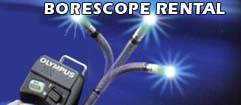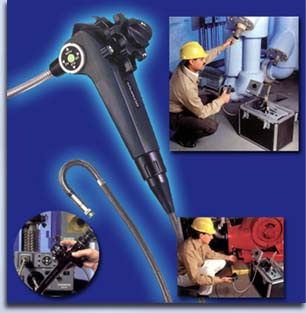

What are the differences between borescopes, fiberscopes, videoscopes and video probes?
What do you need to know in order to recommend a scope for my application?
Should I use a non-articulating scope or an articulating scope?
How do you determine what diameter borescope to use?
What length of scope should I use?
What are the charges and when do they start?
What do you need from us to start the process and what are your terms?
What are the differences between borescopes, fiberscopes, videoscopes and video probes? TOP
A borescope is, literally, a rigid optical device that lets the user look into a remote area through a small opening, and uses a lens system to project an image that can be observed through an eyepiece. A fiberscope is a flexible instrument that does the same thing through the use of fiber optic bundles. The terms videoscope and video probe are interchangeable and refer to a scope that uses a CCD chip in the tip and a fiber optic light guide to obtain an image and project it on a video monitor. The term “Borescope” is often generically used to describe all of these instruments.
What is Articulation? TOP
Some videoscopes have control knobs that allow you to move the tip of the scope in any direction. This allows you to steer your way around bends or obstacles and to inspect side to side and up and down in the inspection area.
What do you need to know in order to recommend a scope for my application? TOP
Know the specifics of your inspection, for instance; What are you inspecting? What is the size of the access opening? How far into the area do you have to go? Are there bends or other obstacles to get around? With this information, we can make the proper recommendation.
Should I use a non-articulating scope or an articulating scope? TOP
This, again, depends on access, but also on what the purpose of the inspection is. The majority of non-articulating pipe camera rentals are for boiler or pipe inspections where there is a fairly large opening (1.75″ plus) and long straight runs with sweeping elbows. The articulating scopes are generally used in areas with smaller access ports and more complicated internals, for example heat exchangers, turbines, tubes with bends, etc.
How do you determine what diameter borescope to use? TOP
The rule of thumb is to use the largest diameter scope that the access will accommodate. This is because the larger the diameter, the larger the fiber optic bundle is, and that means more light at the tip. For instance, if you have a 1/2″ opening into a larger inspection area, an 8 mm diameter should be used. If the same access opening leads into tubing with bends in it, a 6 mm diameter scope should be used.
What length of scope should I use? TOP
We recommend that customers rent a longer scope than needed, just to make sure that they aren’t caught short.
Can I record the inspection? TOP
All systems have digital recording capability, either on-board or through auxiliary equipment. Standard Monitor/VCRs are also available.
What are the charges and when do they start? TOP
We charge according to the type of scope that is rented and the length of the rental period. We also charge shipping from Wexford, PA to your location, or ship on your Fed Ex number. We start charges on the day the scope is received and stop charging on the day the scope is shipped back. We ask that the scope be shipped back standard overnight when the inspection is completed.
What do you need from us to start the process and what are your terms? TOP
After determining what scope system will do the job, we will fax over a contract that should be signed and faxed back. If a P.O. is needed for payment, that can also be faxed to us. If the inspection is an emergency, as is often the case the equipment can be shipped out and the paperwork can catch up the next day. Our terms are net 30 and we will invoice you when the equipment is received back at our office. We also accept most major credit cards.
